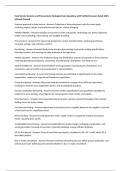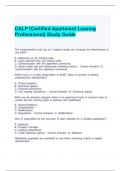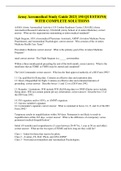Food Service Systems and Procurement Strategies Exam Questions with Verified Answers Rated 100%
(Already Passed)
Systems approach to food service - Answers Collection of interacting parts with the same goals,
involving outputs, inputs, and environmental factors, always changing.
MACRO TRENDS - Answers Includes an increase in chain restaurants, technology use, menu expansion,
family value marketing, value pricing, and multiple branding.
Procurement - Answers First step in the foodservice system transformation, involving purchasing,
receiving, storage, and inventory control.
Purchasing - Answers Essential foodservice function determining food needs, writing specifications,
selecting vendors, and securing the right products at the right time.
Market Channels - Answers The food processing and distribution system from grower to final customer,
involving agricultural production, processing, manufacturing, distribution, and food service.
Market middlemen - Answers Intermediaries working between manufacturers, distributors, and
consumers, such as brokers and manufacturer's representatives.
Centralized purchasing - Answers Purchasing done by one individual or department for the entire
organization, common in large school foodservice operations.
Group purchasing - Answers Joint purchasing by foodservice managers from different operations,
resulting in reduced costs, negotiation power, and standardized practices.
Formal competitive bid buying - Answers Involves written specifications and quantities submitted to
vendors for price quoting, advantageous for canned goods, frozen foods, and staples.
Firm fixed price - Answers A pricing model where the price remains constant throughout the contract,
shifting more risk to the vendor.
Cost plus purchasing - Answers Agreement to buy items from a supplier based on the supplier's cost plus
a fixed mark-up for a specified period.
Prime vending - Answers Formal agreement with a single vendor to supply the majority of product
needs, requiring price audits.
Sustainability in Purchasing - Answers Consideration for product origin, packaging, composition, and
waste generation, focusing on less toxic, minimally polluting, energy-efficient products.
AP (As Purchased) - Answers Form of food when purchased, calculated as AP = EP ÷ yield, where EP is
the edible portion.
Buy or make calculations - Answers Process involving calculating price per edible pound, total labor cost,
and total price per edible pound to decide whether to buy or make a food item.
, Requisition - Answers Internal document created by the purchasing department to order specific food
and supplies.
Purchase order - Answers External document sent to the supplier indicating the intent to buy, with the
supplier acknowledging receipt.
Invoice - Answers Bill created by the supplier for the purchased products.
Controls - Answers Include plans, goals, standards, policies, procedures, programs, and contracts in a
food service system.
Inputs - Answers Resources like labor, materials, food, supplies, facilities, and operational aspects
required by a system.
Operations - Answers Work performed to transform inputs into outputs in a food service system.
Transformation - Answers Process changing inputs into outputs, a key management function in food
service.
Outputs - Answers Finished products and services of an organization in a food service system, leading to
feedback.
Equifinality - Answers Concept highlighting multiple ways to achieve the same output in a food service
system.
Memory - Answers Involves historical data and records, such as financial and personal information, in a
food service system.
Management - Answers Coordination of resources to achieve desired objectives in a food service
system.
4 types food systems - Answers Conventional, commissary, ready/prepared, assembly/serve
equifinality - Answers Getting the same output from different inputs
Receiving - Answers Ensuring products delivered match what was ordered, taking legal ownership and
physical possession
Conventional - Answers Traditional system where raw foods are purchased, prepared on site, and served
soon after preparation
Ready-prepared - Answers Foods prepared on site, chilled or frozen, then reheated for service
Commissary - Answers Central production kitchen delivering prepared foods off-site to remote service
areas like airline catering
Assembly/Serve - Answers Kitchen-less kitchen requiring no on-site food production, common in
hospitals







